
bee-agent-framework
Framework for building scalable agentic applications.
Stars: 1550
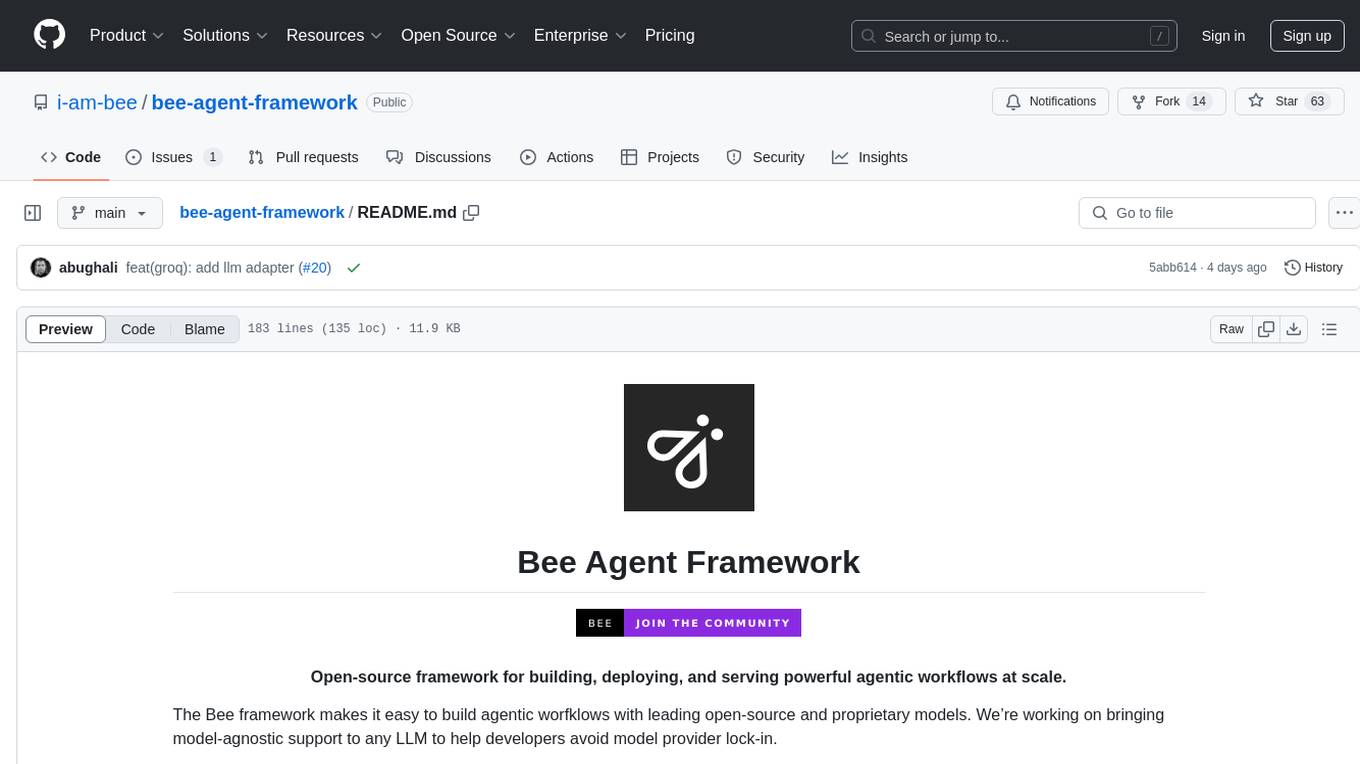
The Bee Agent Framework is an open-source tool for building, deploying, and serving powerful agentic workflows at scale. It provides AI agents, tools for creating workflows in Javascript/Python, a code interpreter, memory optimization strategies, serialization for pausing/resuming workflows, traceability features, production-level control, and upcoming features like model-agnostic support and a chat UI. The framework offers various modules for agents, llms, memory, tools, caching, errors, adapters, logging, serialization, and more, with a roadmap including MLFlow integration, JSON support, structured outputs, chat client, base agent improvements, guardrails, and evaluation.
README:
🐝 Bee Agent Framework is an open-source TypeScript library for building production-ready multi-agent systems. Pick from a variety of 🌐 LLM providers, customize the 📜 prompt templates, create 🤖 agents, equip agents with pre-made 🛠️ tools, and orchestrate 🤖🤝🤖 multi-agent workflows! 🪄
- 🚀 2025-01-09:
- Introduced Workflows, a way of building multi-agent systems.
- Added support for Model Context Protocol, featured on the official page.
- 🚀 2024-12-09: Added support for LLaMa 3.3.
- 🚀 2024-11-21: Added an experimental Streamlit agent.
For a full changelog, see the releases page.
- ⚔️ Battle-tested. Bee Agent Framework is at the core of BeeAI, a powerful platform for building chat assistants and custom AI-powered apps. BeeAI is in a closed beta, but already used by hundreds of users. And it's fully open-source too!
- 🚀 Production-grade. In an actual product, you have to reduce token spend through memory strategies, store and restore the agent state through (de)serialization, generate structured output, or execute generated code in a sandboxed environment. Leave all that to Bee and focus on building!
- 🤗 Built for open-source models. Pick any LLM you want – including small and open-source models. The framework is designed to perform robustly with Granite and Llama 3.x. A full agentic workflow can run on your laptop!
- 😢 Bee cares about the sad path too. Real-world applications encounter errors and failures. Bee lets you observe the full agent workflow through events, collect telemetry, log diagnostic data, and throws clear and well-defined exceptions. Bees may be insects, but not bugs!
- 🌳 A part of something greater. Bee isn't just a framework, but a full ecosystem. Use Bee UI to chat with your agents visually. Bee Observe collects and manages telemetry. Bee Code Interpreter runs generated code safely in a secure sandbox. The Bee ecosystem also integrates with Model Context Protocol, allowing interoperability with the wider agent ecosystem!
This example demonstrates how to build a multi-agent workflow using Bee Agent Framework:
import "dotenv/config";
import { UnconstrainedMemory } from "bee-agent-framework/memory/unconstrainedMemory";
import { OpenMeteoTool } from "bee-agent-framework/tools/weather/openMeteo";
import { WikipediaTool } from "bee-agent-framework/tools/search/wikipedia";
import { AgentWorkflow } from "bee-agent-framework/experimental/workflows/agent";
import { BaseMessage, Role } from "bee-agent-framework/llms/primitives/message";
import { GroqChatLLM } from "bee-agent-framework/adapters/groq/chat";
const workflow = new AgentWorkflow();
workflow.addAgent({
name: "Researcher",
instructions: "You are a researcher assistant. Respond only if you can provide a useful answer.",
tools: [new WikipediaTool()],
llm: new GroqChatLLM(),
});
workflow.addAgent({
name: "WeatherForecaster",
instructions: "You are a weather assistant. Respond only if you can provide a useful answer.",
tools: [new OpenMeteoTool()],
llm: new GroqChatLLM(),
execution: { maxIterations: 3 },
});
workflow.addAgent({
name: "Solver",
instructions:
"Your task is to provide the most useful final answer based on the assistants' responses which all are relevant. Ignore those where assistant do not know.",
llm: new GroqChatLLM(),
});
const memory = new UnconstrainedMemory();
await memory.add(
BaseMessage.of({
role: Role.USER,
text: "What is the capital of France and what is the current weather there?",
meta: { createdAt: new Date() },
}),
);
const { result } = await workflow.run(memory.messages).observe((emitter) => {
emitter.on("success", (data) => {
console.log(`-> ${data.step}`, data.response?.update?.finalAnswer ?? "-");
});
});
console.log(`Agent 🤖`, result.finalAnswer);[!TIP]
🚀 Would you like a fully set-up TypeScript project with Bee, Code Interpreter, and Observability? Check out our Bee Framework Starter.
[!TIP]
🚀 Would you like to work with Bee in your web browser? See Bee Stack
npm install bee-agent-frameworkor
yarn add bee-agent-frameworkimport { BeeAgent } from "bee-agent-framework/agents/bee/agent";
import { OllamaChatLLM } from "bee-agent-framework/adapters/ollama/chat";
import { TokenMemory } from "bee-agent-framework/memory/tokenMemory";
import { DuckDuckGoSearchTool } from "bee-agent-framework/tools/search/duckDuckGoSearch";
import { OpenMeteoTool } from "bee-agent-framework/tools/weather/openMeteo";
const llm = new OllamaChatLLM(); // default is llama3.1 (8B), it is recommended to use 70B model
const agent = new BeeAgent({
llm, // for more explore 'bee-agent-framework/adapters'
memory: new TokenMemory({ llm }), // for more explore 'bee-agent-framework/memory'
tools: [new DuckDuckGoSearchTool(), new OpenMeteoTool()], // for more explore 'bee-agent-framework/tools'
});
const response = await agent
.run({ prompt: "What's the current weather in Las Vegas?" })
.observe((emitter) => {
emitter.on("update", async ({ data, update, meta }) => {
console.log(`Agent (${update.key}) 🤖 : `, update.value);
});
});
console.log(`Agent 🤖 : `, response.result.text);➡️ See a more advanced example.
➡️ you can run this example after local installation, using the command yarn start examples/agents/simple.ts
[!TIP]
To run this example, be sure that you have installed ollama with the llama3.1 model downloaded.
[!TIP]
Documentation is available at https://i-am-bee.github.io/bee-agent-framework/
[!NOTE]
yarnshould be installed via Corepack (tutorial)
- Clone the repository
git clone [email protected]:i-am-bee/bee-agent-framework. - Install dependencies
yarn install --immutable && yarn prepare. - Create
.env(from.env.template) and fill in missing values (if any). - Start the agent
yarn run start:bee(it runs/examples/agents/bee.tsfile).
➡️ All examples can be found in the examples directory.
➡️ To run an arbitrary example, use the following command yarn start examples/agents/bee.ts (just pass the appropriate path to the desired example).
The source directory (src) provides numerous modules that one can use.
| Name | Description |
|---|---|
| agents | Base classes defining the common interface for agent. |
| workflows | Build agentic applications in a declarative way via workflows. |
| llms | Base classes defining the common interface for text inference (standard or chat). |
| template | Prompt Templating system based on Mustache with various improvements. |
| memory | Various types of memories to use with agent. |
| tools | Tools that an agent can use. |
| cache | Preset of different caching approaches that can be used together with tools. |
| errors | Error classes and helpers to catch errors fast. |
| adapters | Concrete implementations of given modules for different environments. |
| logger | Core component for logging all actions within the framework. |
| serializer | Core component for the ability to serialize/deserialize modules into the serialized format. |
| version | Constants representing the framework (e.g., latest version) |
| emitter | Bringing visibility to the system by emitting events. |
| internals | Modules used by other modules within the framework. |
To see more in-depth explanation see overview.
- Python version
- Multi-agent orchestration patterns
- Catalog of agents
The Bee Agent Framework is an open-source project and we ❤️ contributions.
If you'd like to contribute to Bee, please take a look at our contribution guidelines.
We are using GitHub Issues to manage our public bugs. We keep a close eye on this, so before filing a new issue, please check to make sure it hasn't already been logged.
This project and everyone participating in it are governed by the Code of Conduct. By participating, you are expected to uphold this code. Please read the full text so that you can read which actions may or may not be tolerated.
All content in these repositories including code has been provided by IBM under the associated open source software license and IBM is under no obligation to provide enhancements, updates, or support. IBM developers produced this code as an open source project (not as an IBM product), and IBM makes no assertions as to the level of quality nor security, and will not be maintaining this code going forward.
Special thanks to our contributors for helping us improve Bee Agent Framework.
For Tasks:
Click tags to check more tools for each tasksFor Jobs:
Alternative AI tools for bee-agent-framework
Similar Open Source Tools

bee-agent-framework
The Bee Agent Framework is an open-source tool for building, deploying, and serving powerful agentic workflows at scale. It provides AI agents, tools for creating workflows in Javascript/Python, a code interpreter, memory optimization strategies, serialization for pausing/resuming workflows, traceability features, production-level control, and upcoming features like model-agnostic support and a chat UI. The framework offers various modules for agents, llms, memory, tools, caching, errors, adapters, logging, serialization, and more, with a roadmap including MLFlow integration, JSON support, structured outputs, chat client, base agent improvements, guardrails, and evaluation.
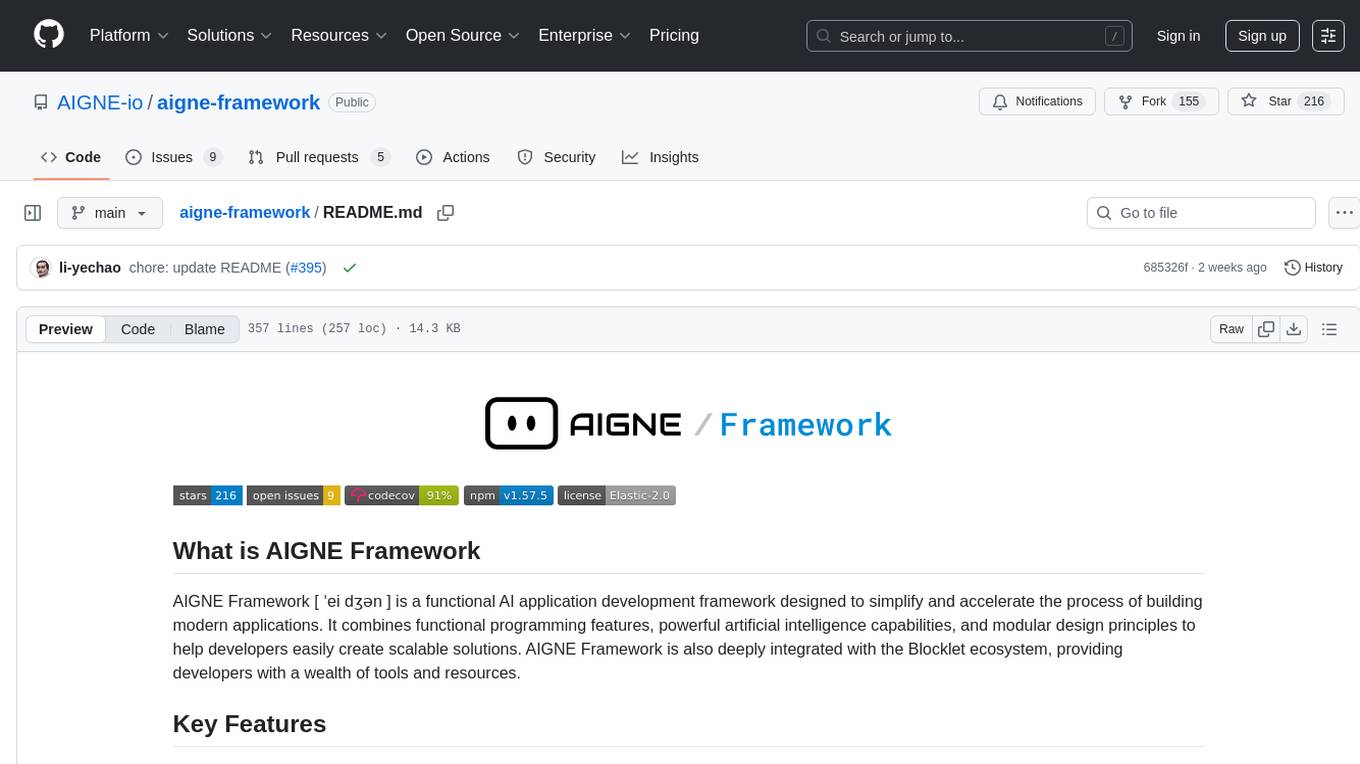
aigne-framework
AIGNE Framework is a functional AI application development framework designed to simplify and accelerate the process of building modern applications. It combines functional programming features, powerful artificial intelligence capabilities, and modular design principles to help developers easily create scalable solutions. With key features like modular design, TypeScript support, multiple AI model support, flexible workflow patterns, MCP protocol integration, code execution capabilities, and Blocklet ecosystem integration, AIGNE Framework offers a comprehensive solution for developers. The framework provides various workflow patterns such as Workflow Router, Workflow Sequential, Workflow Concurrency, Workflow Handoff, Workflow Reflection, Workflow Orchestration, Workflow Code Execution, and Workflow Group Chat to address different application scenarios efficiently. It also includes built-in MCP support for running MCP servers and integrating with external MCP servers, along with packages for core functionality, agent library, CLI, and various models like OpenAI, Gemini, Claude, and Nova.
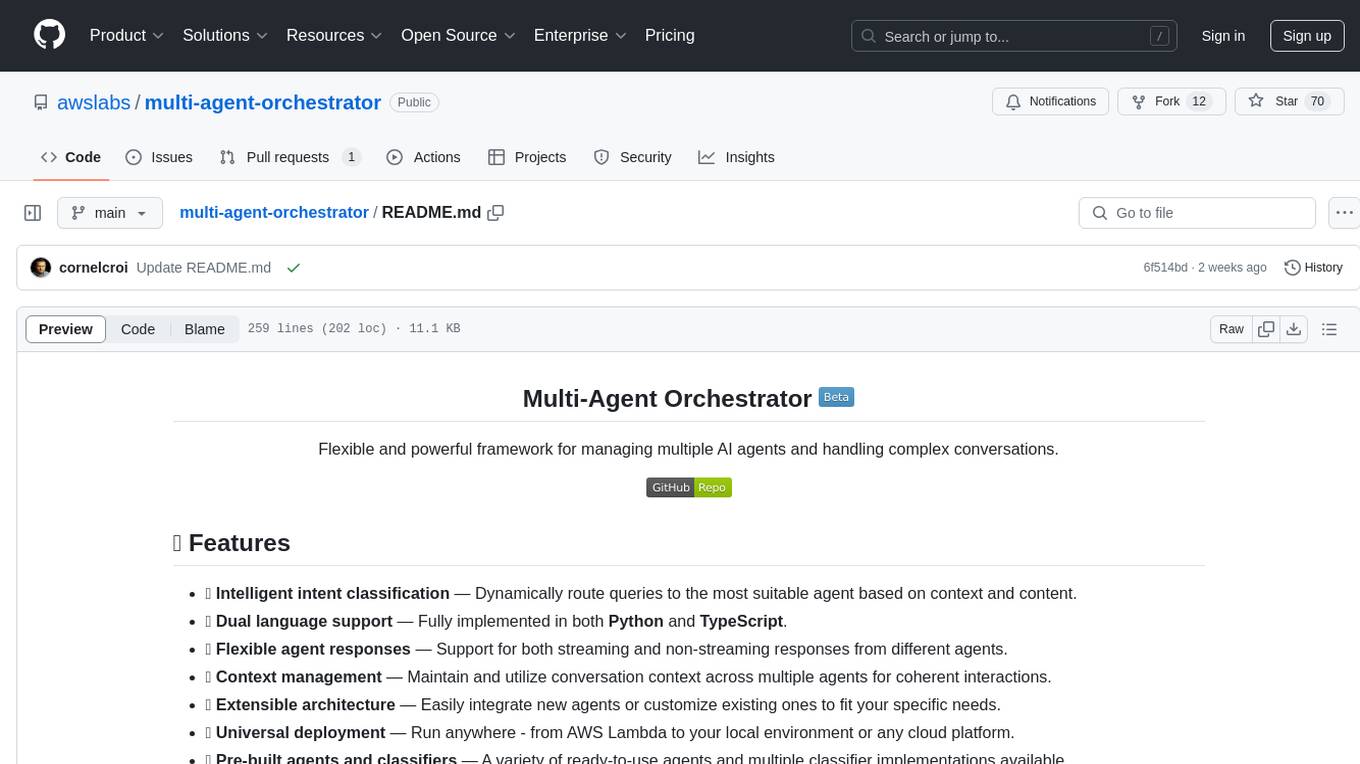
multi-agent-orchestrator
Multi-Agent Orchestrator is a flexible and powerful framework for managing multiple AI agents and handling complex conversations. It intelligently routes queries to the most suitable agent based on context and content, supports dual language implementation in Python and TypeScript, offers flexible agent responses, context management across agents, extensible architecture for customization, universal deployment options, and pre-built agents and classifiers. It is suitable for various applications, from simple chatbots to sophisticated AI systems, accommodating diverse requirements and scaling efficiently.
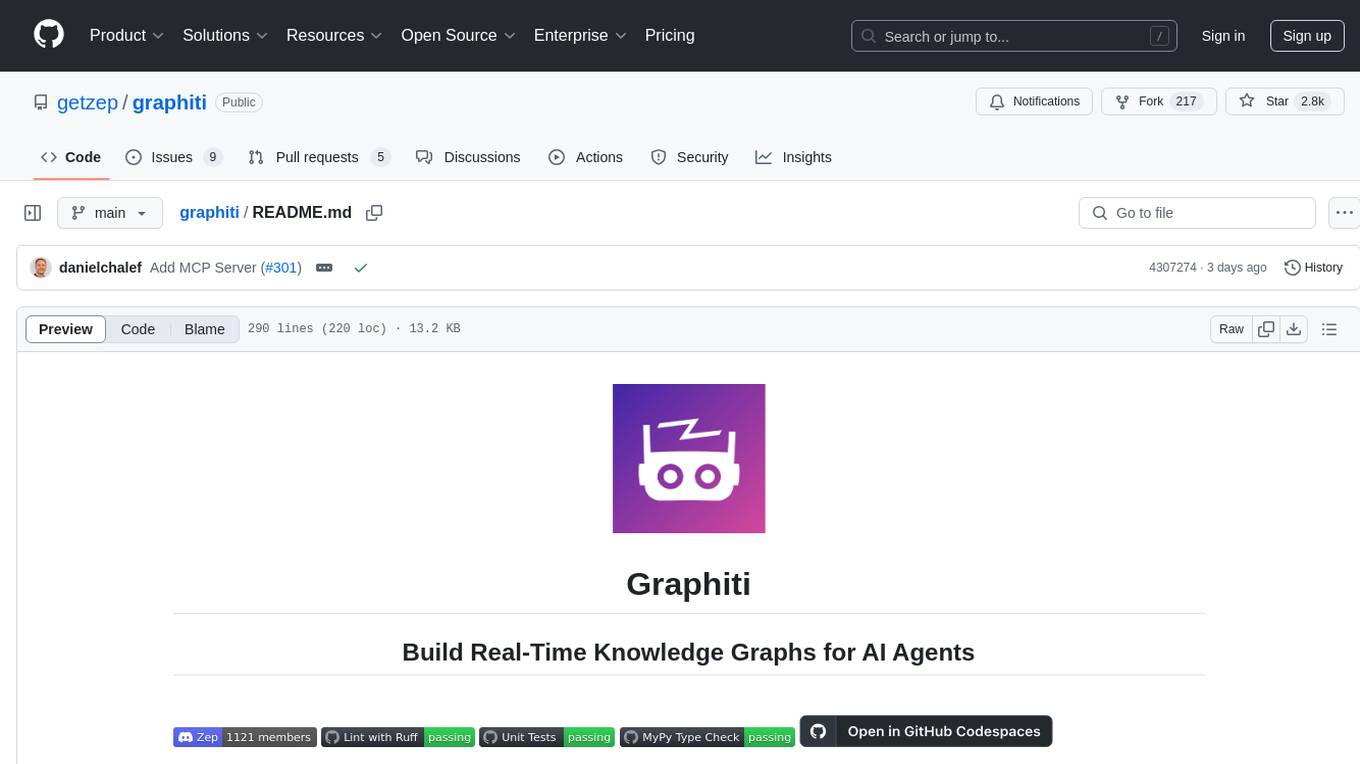
graphiti
Graphiti is a framework for building and querying temporally-aware knowledge graphs, tailored for AI agents in dynamic environments. It continuously integrates user interactions, structured and unstructured data, and external information into a coherent, queryable graph. The framework supports incremental data updates, efficient retrieval, and precise historical queries without complete graph recomputation, making it suitable for developing interactive, context-aware AI applications.
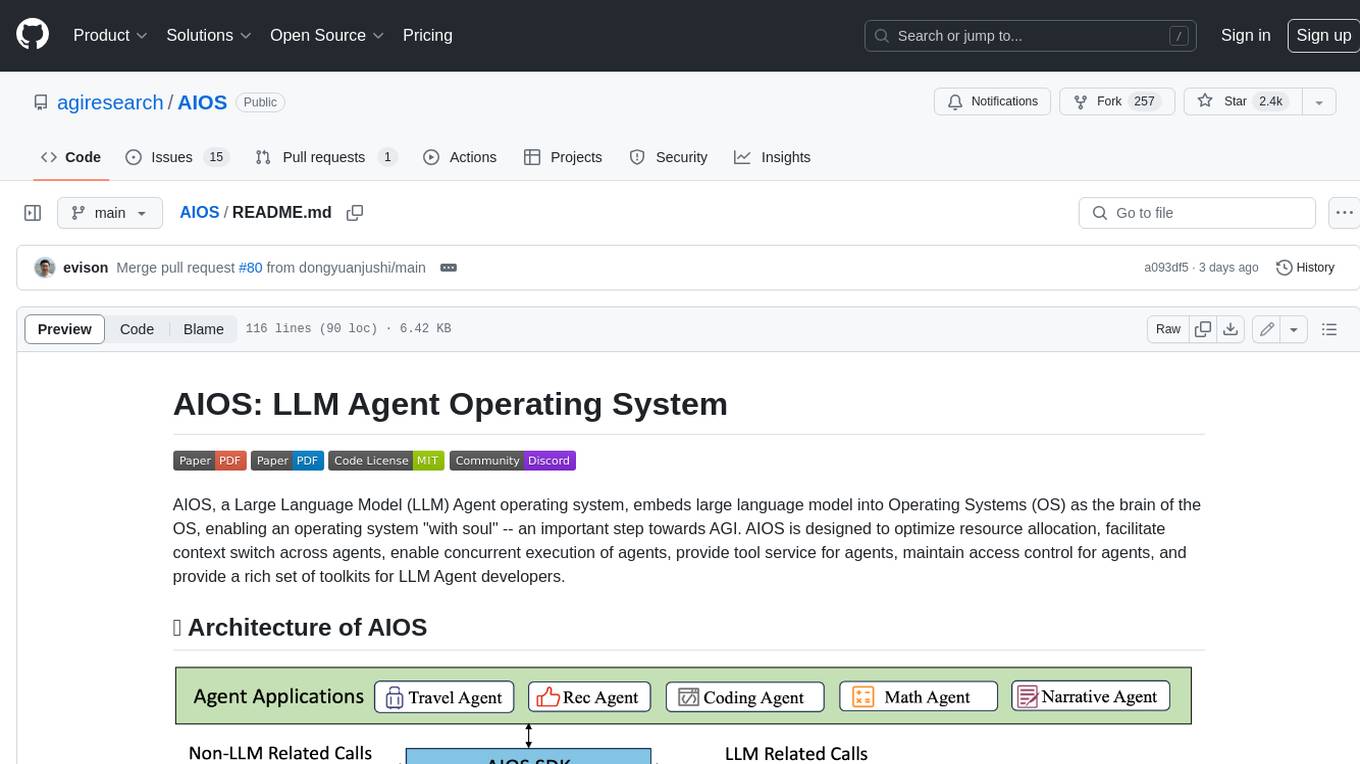
AIOS
AIOS, a Large Language Model (LLM) Agent operating system, embeds large language model into Operating Systems (OS) as the brain of the OS, enabling an operating system "with soul" -- an important step towards AGI. AIOS is designed to optimize resource allocation, facilitate context switch across agents, enable concurrent execution of agents, provide tool service for agents, maintain access control for agents, and provide a rich set of toolkits for LLM Agent developers.
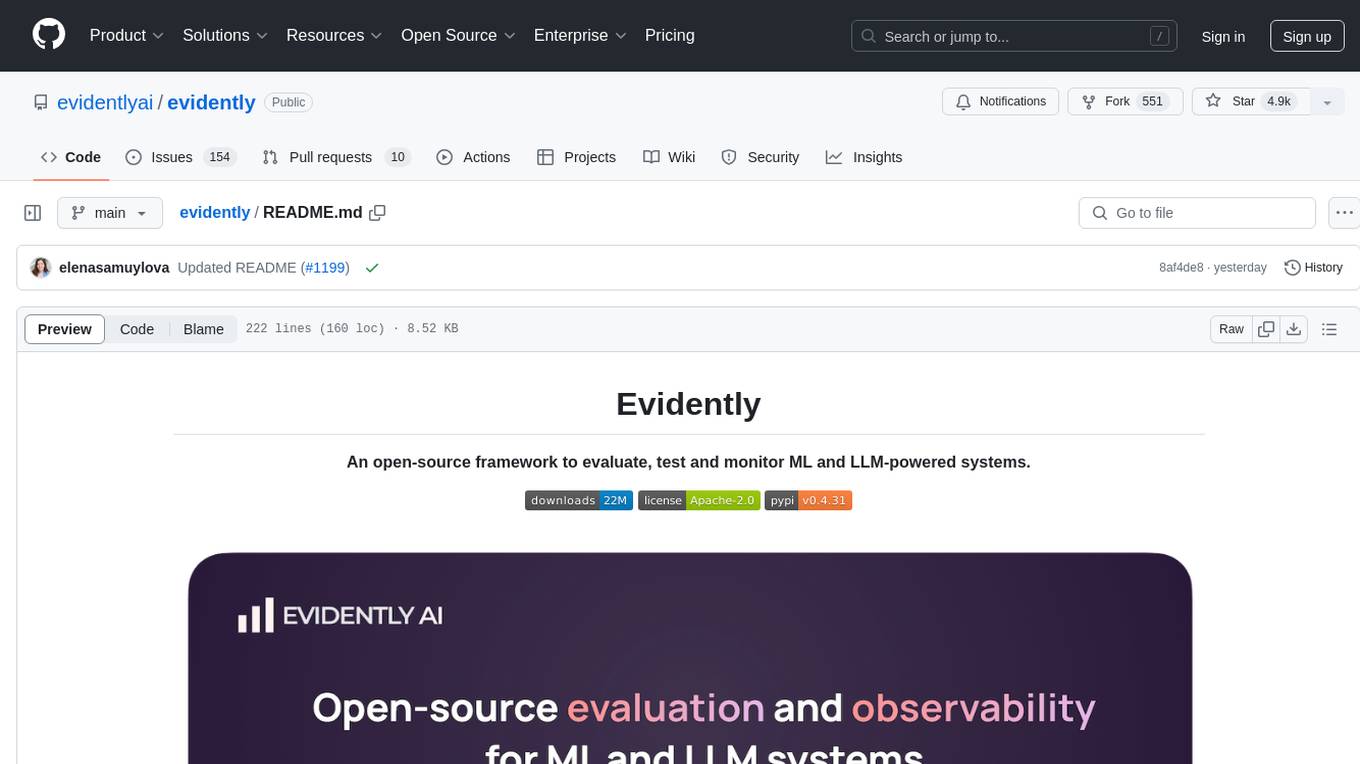
evidently
Evidently is an open-source Python library designed for evaluating, testing, and monitoring machine learning (ML) and large language model (LLM) powered systems. It offers a wide range of functionalities, including working with tabular, text data, and embeddings, supporting predictive and generative systems, providing over 100 built-in metrics for data drift detection and LLM evaluation, allowing for custom metrics and tests, enabling both offline evaluations and live monitoring, and offering an open architecture for easy data export and integration with existing tools. Users can utilize Evidently for one-off evaluations using Reports or Test Suites in Python, or opt for real-time monitoring through the Dashboard service.
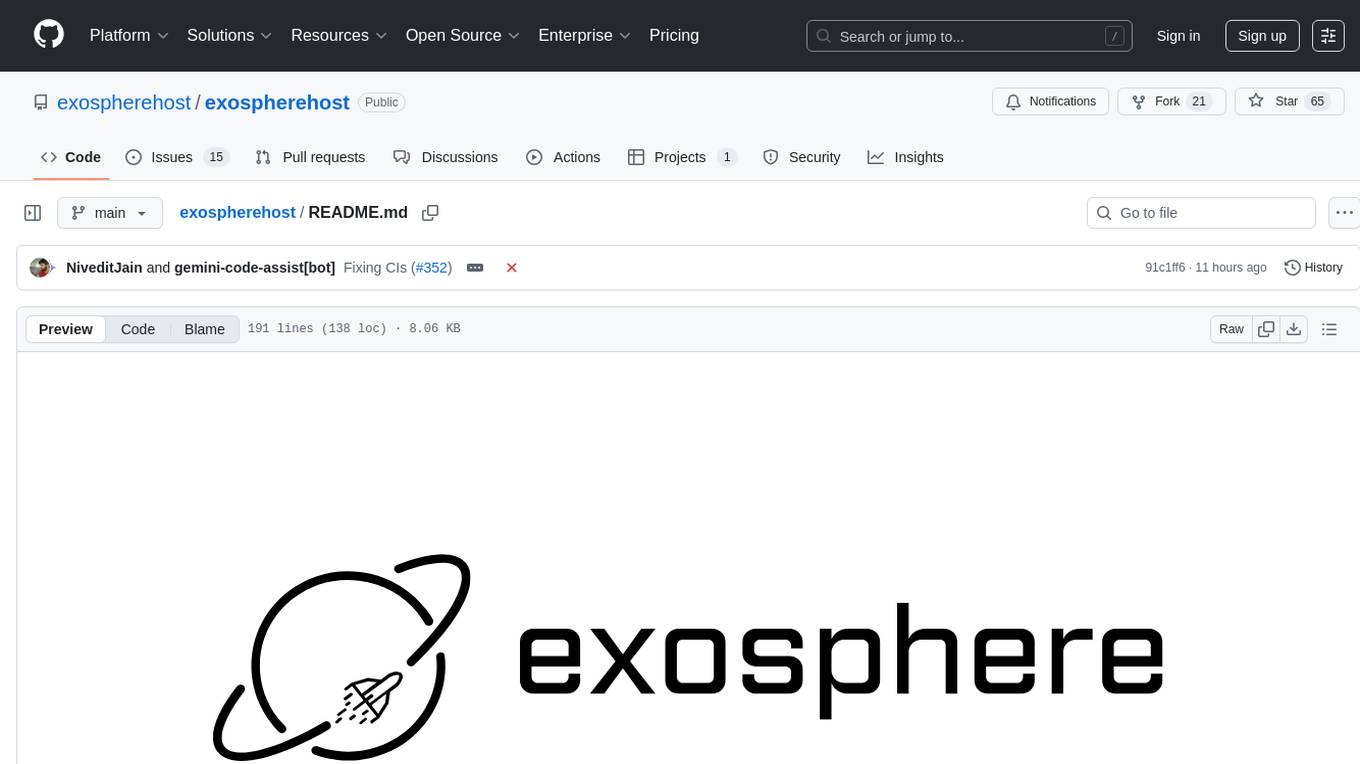
exospherehost
Exosphere is an open source infrastructure designed to run AI agents at scale for large data and long running flows. It allows developers to define plug and playable nodes that can be run on a reliable backbone in the form of a workflow, with features like dynamic state creation at runtime, infinite parallel agents, persistent state management, and failure handling. This enables the deployment of production agents that can scale beautifully to build robust autonomous AI workflows.
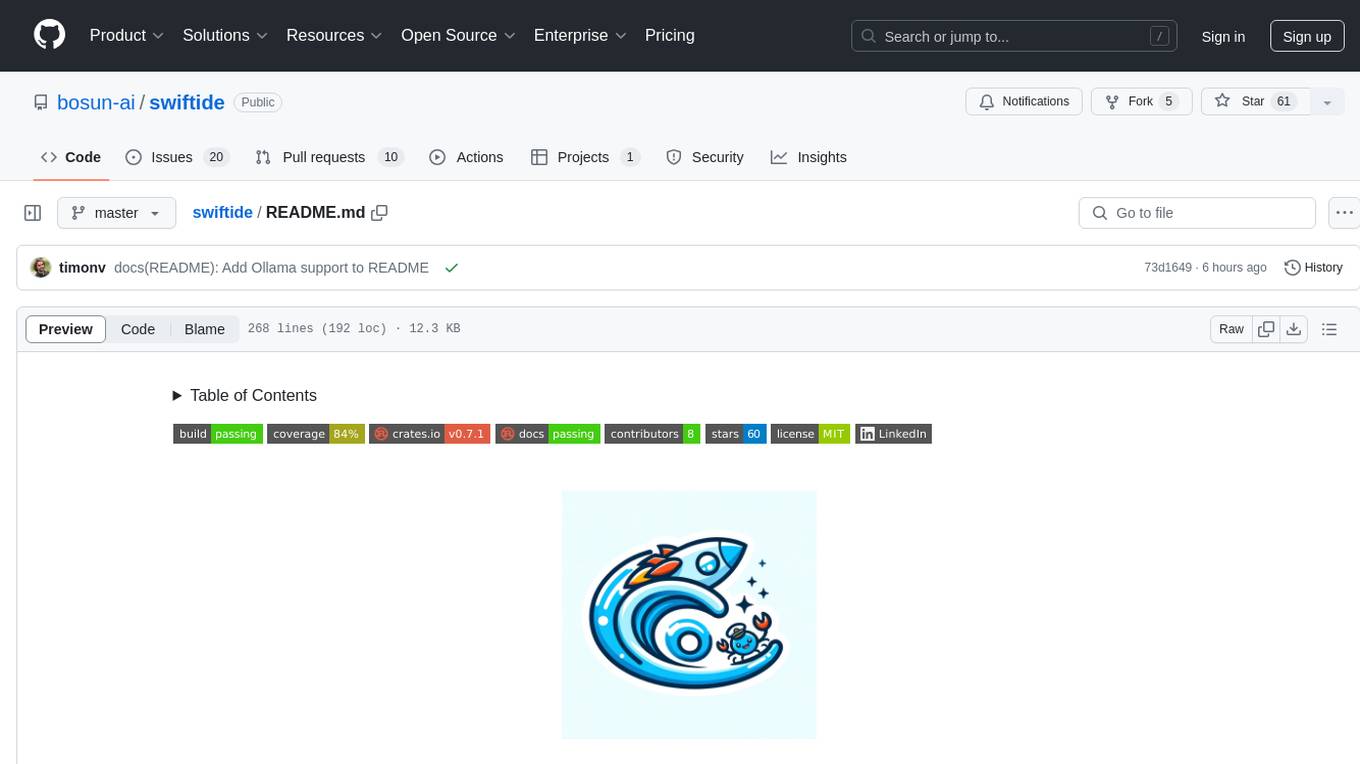
swiftide
Swiftide is a fast, streaming indexing and query library tailored for Retrieval Augmented Generation (RAG) in AI applications. It is built in Rust, utilizing parallel, asynchronous streams for blazingly fast performance. With Swiftide, users can easily build AI applications from idea to production in just a few lines of code. The tool addresses frustrations around performance, stability, and ease of use encountered while working with Python-based tooling. It offers features like fast streaming indexing pipeline, experimental query pipeline, integrations with various platforms, loaders, transformers, chunkers, embedders, and more. Swiftide aims to provide a platform for data indexing and querying to advance the development of automated Large Language Model (LLM) applications.
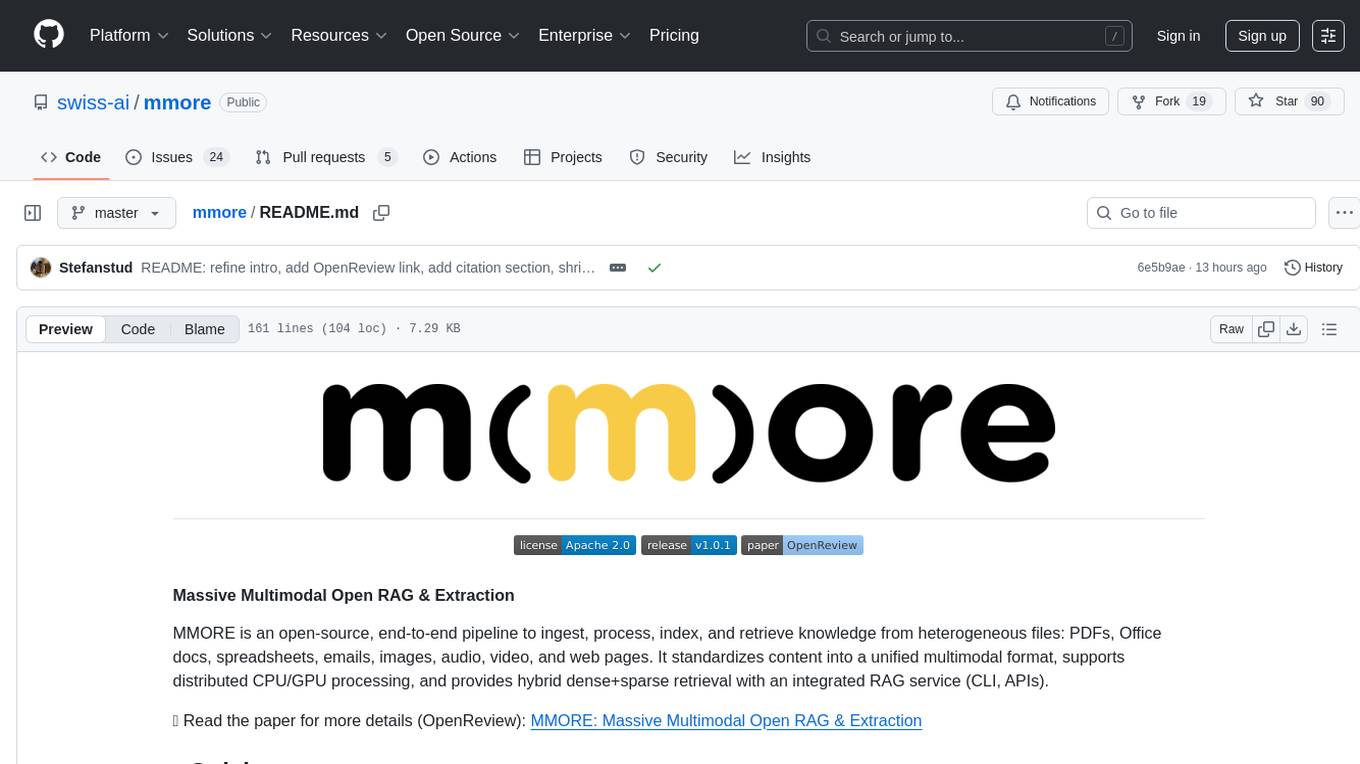
mmore
MMORE is an open-source, end-to-end pipeline for ingesting, processing, indexing, and retrieving knowledge from various file types such as PDFs, Office docs, images, audio, video, and web pages. It standardizes content into a unified multimodal format, supports distributed CPU/GPU processing, and offers hybrid dense+sparse retrieval with an integrated RAG service through CLI and APIs.
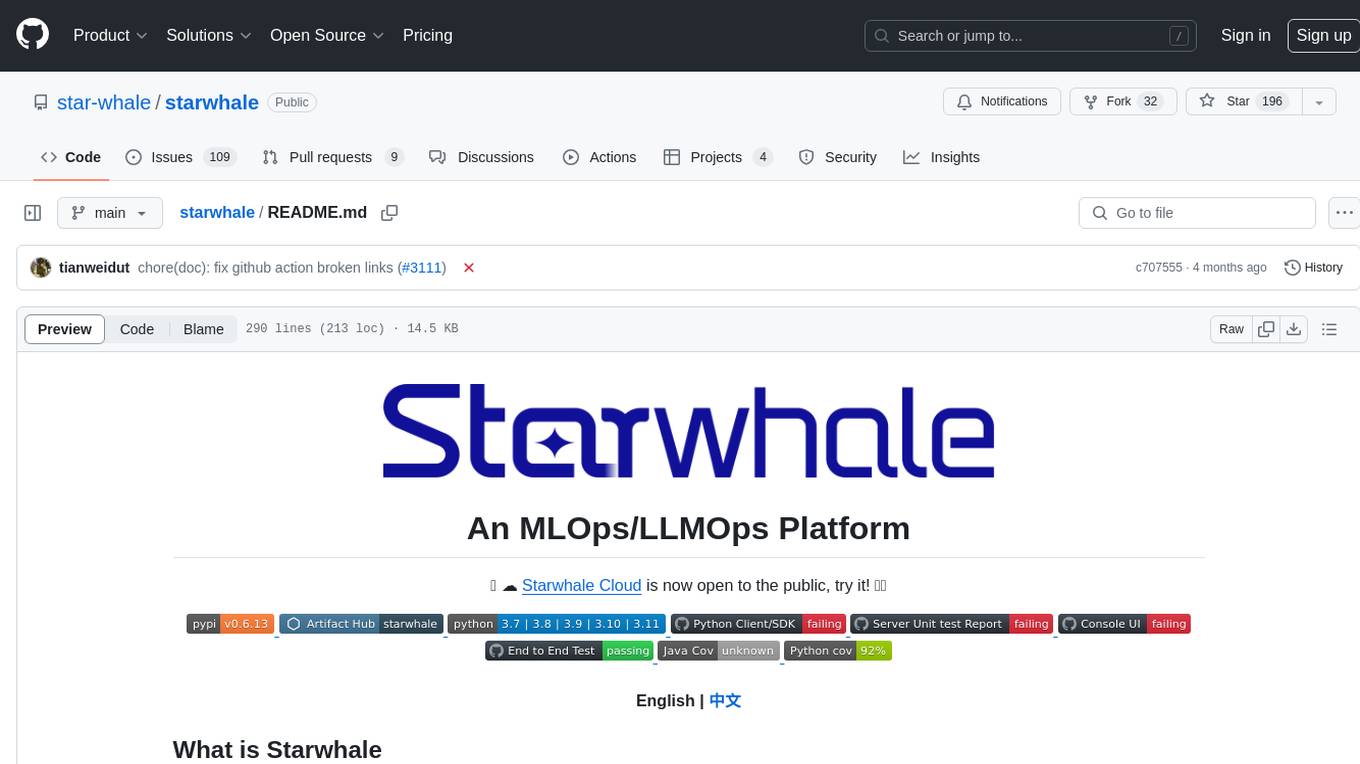
starwhale
Starwhale is an MLOps/LLMOps platform that brings efficiency and standardization to machine learning operations. It streamlines the model development lifecycle, enabling teams to optimize workflows around key areas like model building, evaluation, release, and fine-tuning. Starwhale abstracts Model, Runtime, and Dataset as first-class citizens, providing tailored capabilities for common workflow scenarios including Models Evaluation, Live Demo, and LLM Fine-tuning. It is an open-source platform designed for clarity and ease of use, empowering developers to build customized MLOps features tailored to their needs.
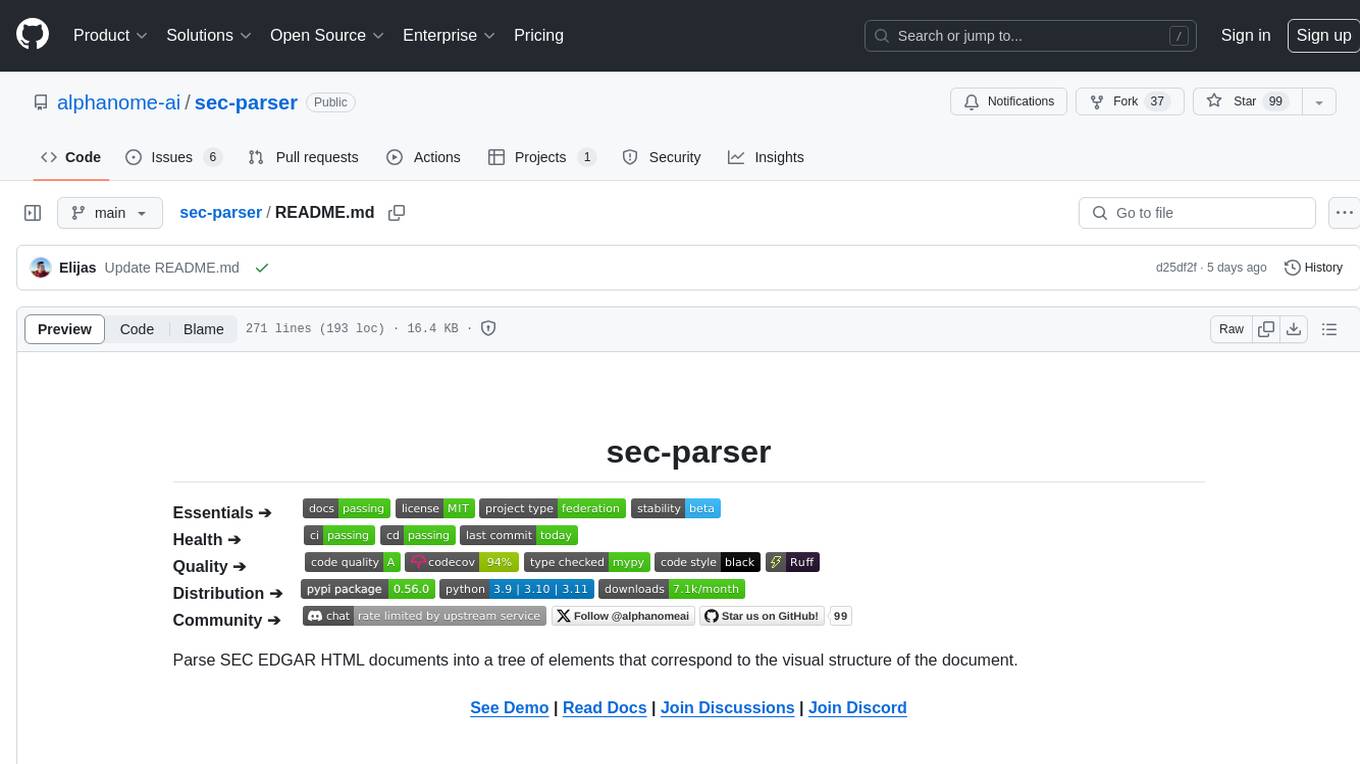
sec-parser
The `sec-parser` project simplifies extracting meaningful information from SEC EDGAR HTML documents by organizing them into semantic elements and a tree structure. It helps in parsing SEC filings for financial and regulatory analysis, analytics and data science, AI and machine learning, causal AI, and large language models. The tool is especially beneficial for AI, ML, and LLM applications by streamlining data pre-processing and feature extraction.
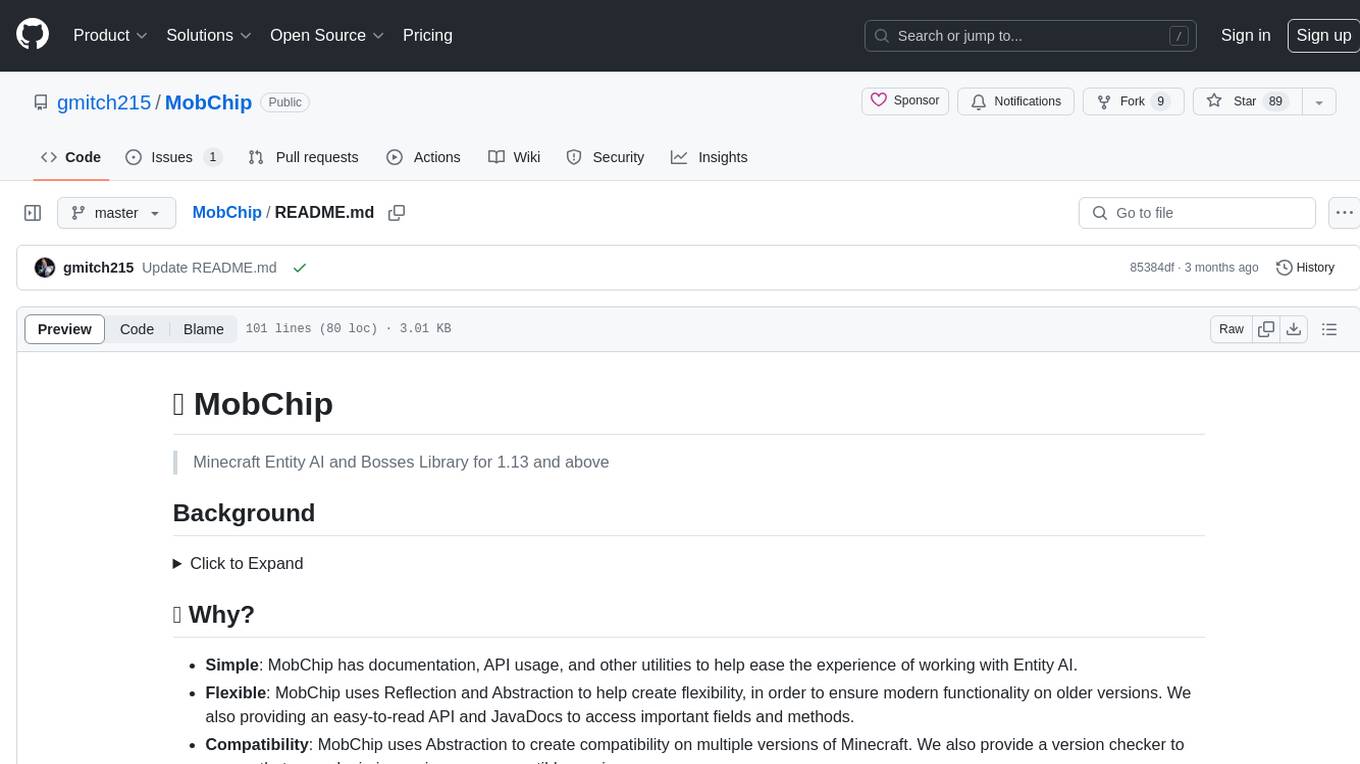
MobChip
MobChip is an all-in-one Entity AI and Bosses Library for Minecraft 1.13 and above. It simplifies the implementation of Minecraft's native entity AI into plugins, offering documentation, API usage, and utilities for ease of use. The library is flexible, using Reflection and Abstraction for modern functionality on older versions, and ensuring compatibility across multiple Minecraft versions. MobChip is open source, providing features like Bosses Library, Pathfinder Goals, Behaviors, Villager Gossip, Ender Dragon Phases, and more.

weave
Weave is a toolkit for developing Generative AI applications, built by Weights & Biases. With Weave, you can log and debug language model inputs, outputs, and traces; build rigorous, apples-to-apples evaluations for language model use cases; and organize all the information generated across the LLM workflow, from experimentation to evaluations to production. Weave aims to bring rigor, best-practices, and composability to the inherently experimental process of developing Generative AI software, without introducing cognitive overhead.
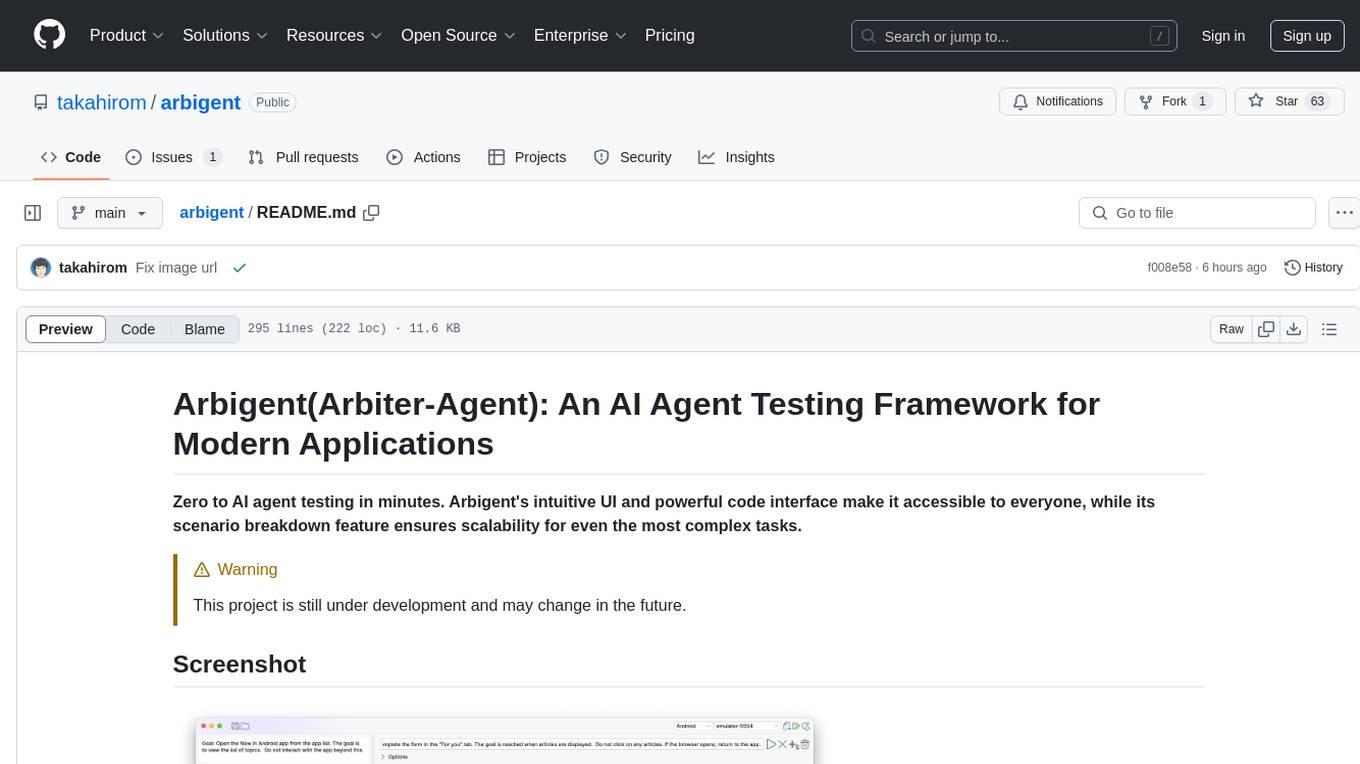
arbigent
Arbigent (Arbiter-Agent) is an AI agent testing framework designed to make AI agent testing practical for modern applications. It addresses challenges faced by traditional UI testing frameworks and AI agents by breaking down complex tasks into smaller, dependent scenarios. The framework is customizable for various AI providers, operating systems, and form factors, empowering users with extensive customization capabilities. Arbigent offers an intuitive UI for scenario creation and a powerful code interface for seamless test execution. It supports multiple form factors, optimizes UI for AI interaction, and is cost-effective by utilizing models like GPT-4o mini. With a flexible code interface and open-source nature, Arbigent aims to revolutionize AI agent testing in modern applications.
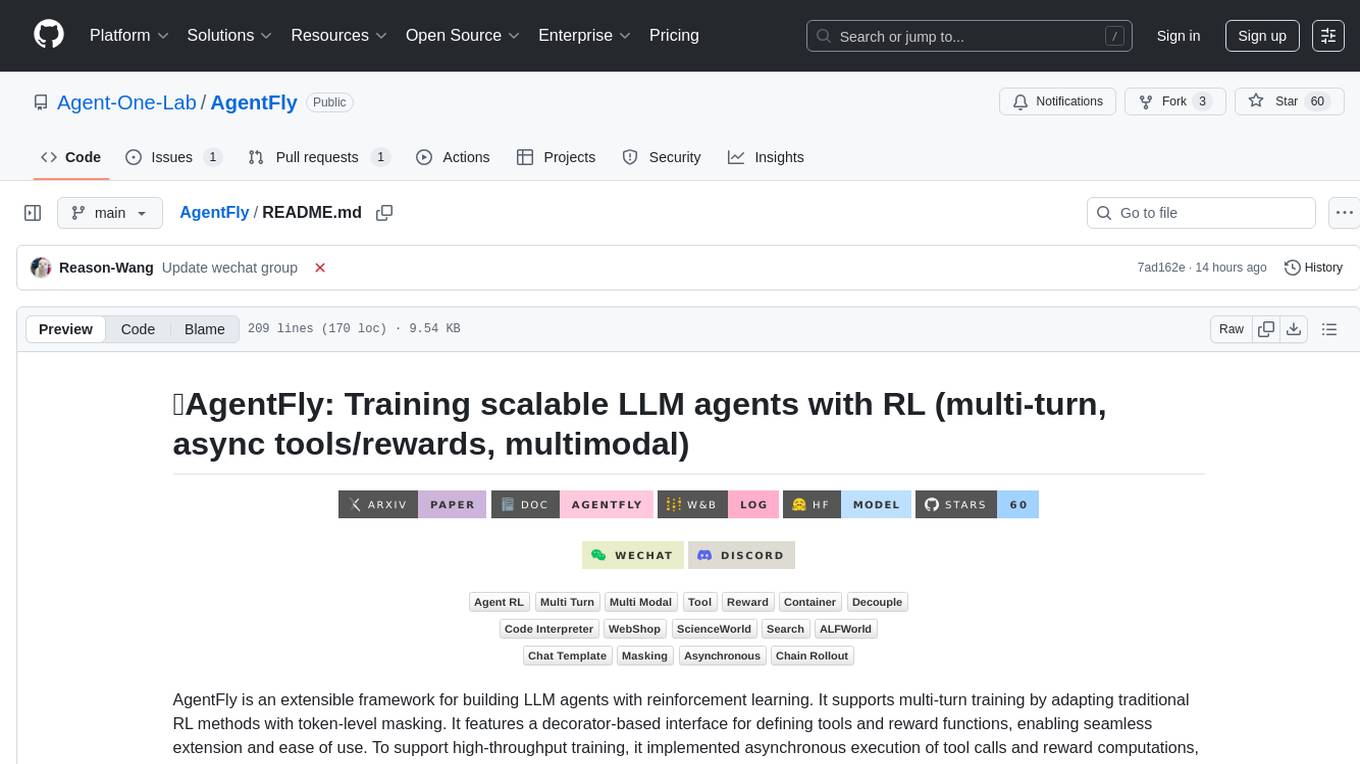
AgentFly
AgentFly is an extensible framework for building LLM agents with reinforcement learning. It supports multi-turn training by adapting traditional RL methods with token-level masking. It features a decorator-based interface for defining tools and reward functions, enabling seamless extension and ease of use. To support high-throughput training, it implemented asynchronous execution of tool calls and reward computations, and designed a centralized resource management system for scalable environment coordination. A suite of prebuilt tools and environments are provided.
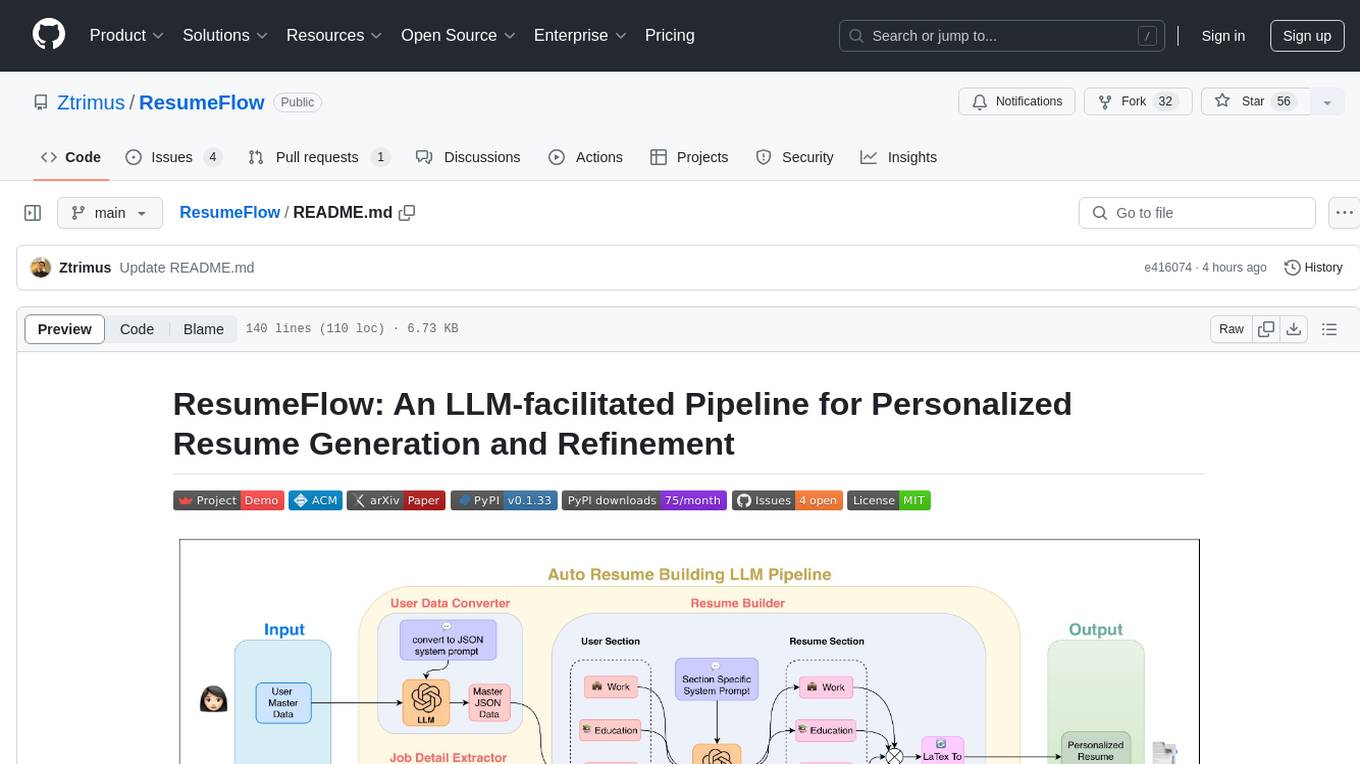
ResumeFlow
ResumeFlow is an automated system that leverages Large Language Models (LLMs) to streamline the job application process. By integrating LLM technology, the tool aims to automate various stages of job hunting, making it easier for users to apply for jobs. Users can access ResumeFlow as a web tool, install it as a Python package, or download the source code from GitHub. The tool requires Python 3.11.6 or above and an LLM API key from OpenAI or Gemini Pro for usage. ResumeFlow offers functionalities such as generating curated resumes and cover letters based on job URLs and user's master resume data.
For similar tasks
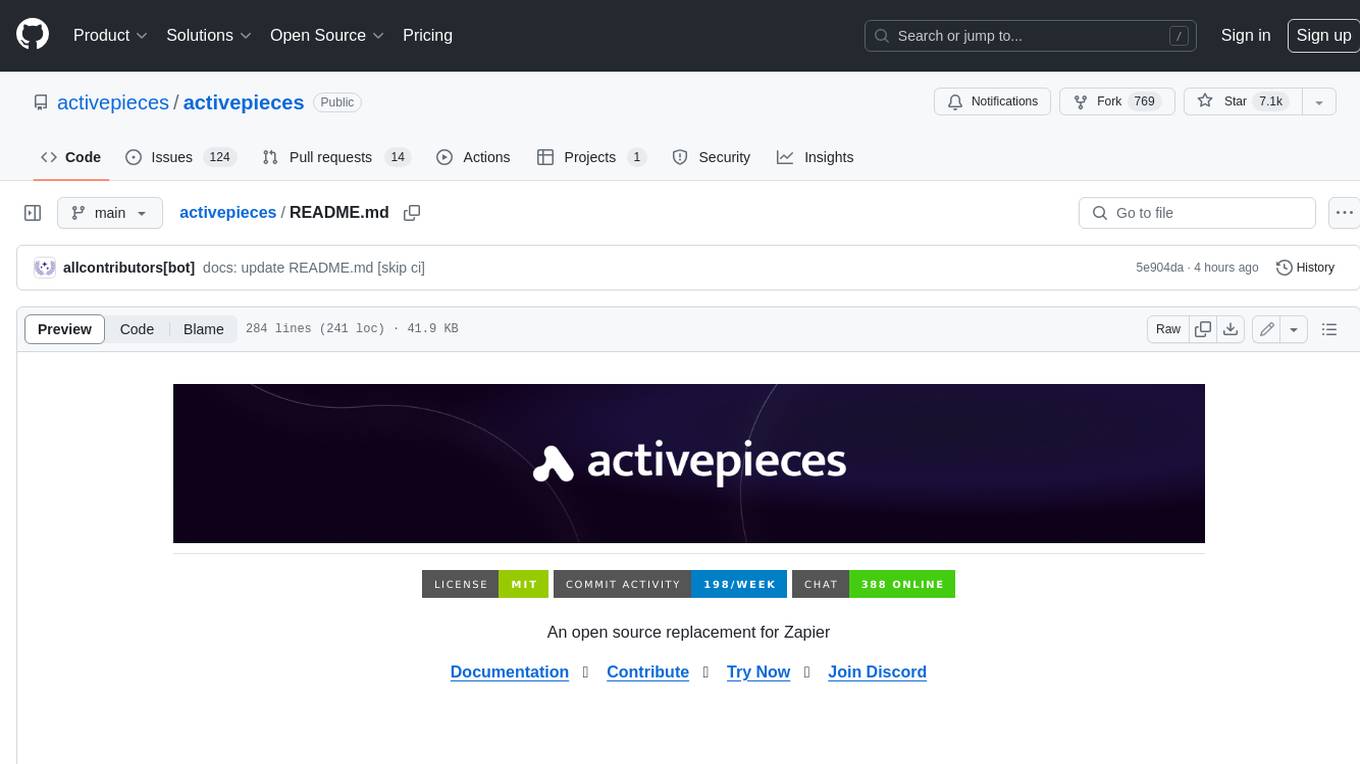
activepieces
Activepieces is an open source replacement for Zapier, designed to be extensible through a type-safe pieces framework written in Typescript. It features a user-friendly Workflow Builder with support for Branches, Loops, and Drag and Drop. Activepieces integrates with Google Sheets, OpenAI, Discord, and RSS, along with 80+ other integrations. The list of supported integrations continues to grow rapidly, thanks to valuable contributions from the community. Activepieces is an open ecosystem; all piece source code is available in the repository, and they are versioned and published directly to npmjs.com upon contributions. If you cannot find a specific piece on the pieces roadmap, please submit a request by visiting the following link: Request Piece Alternatively, if you are a developer, you can quickly build your own piece using our TypeScript framework. For guidance, please refer to the following guide: Contributor's Guide

bee-agent-framework
The Bee Agent Framework is an open-source tool for building, deploying, and serving powerful agentic workflows at scale. It provides AI agents, tools for creating workflows in Javascript/Python, a code interpreter, memory optimization strategies, serialization for pausing/resuming workflows, traceability features, production-level control, and upcoming features like model-agnostic support and a chat UI. The framework offers various modules for agents, llms, memory, tools, caching, errors, adapters, logging, serialization, and more, with a roadmap including MLFlow integration, JSON support, structured outputs, chat client, base agent improvements, guardrails, and evaluation.
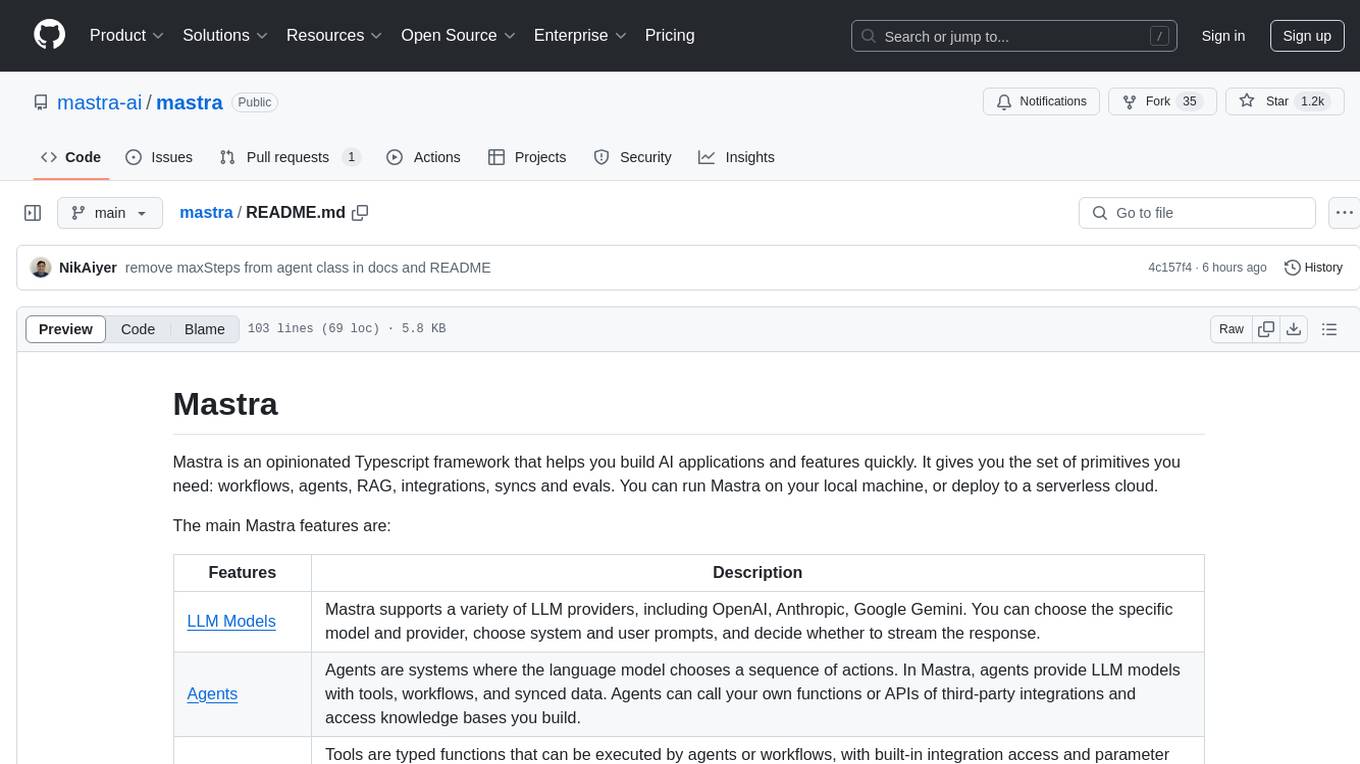
mastra
Mastra is an opinionated Typescript framework designed to help users quickly build AI applications and features. It provides primitives such as workflows, agents, RAG, integrations, syncs, and evals. Users can run Mastra locally or deploy it to a serverless cloud. The framework supports various LLM providers, offers tools for building language models, workflows, and accessing knowledge bases. It includes features like durable graph-based state machines, retrieval-augmented generation, integrations, syncs, and automated tests for evaluating LLM outputs.
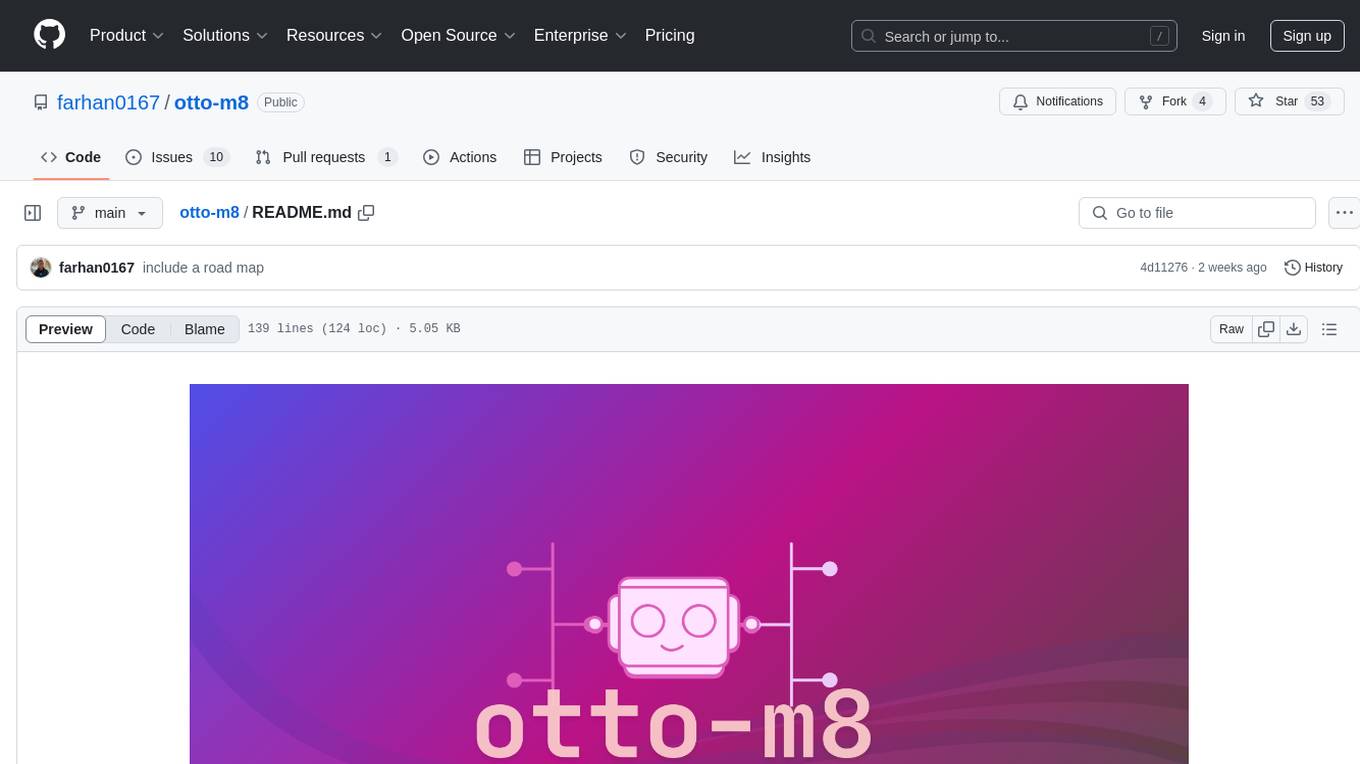
otto-m8
otto-m8 is a flowchart based automation platform designed to run deep learning workloads with minimal to no code. It provides a user-friendly interface to spin up a wide range of AI models, including traditional deep learning models and large language models. The tool deploys Docker containers of workflows as APIs for integration with existing workflows, building AI chatbots, or standalone applications. Otto-m8 operates on an Input, Process, Output paradigm, simplifying the process of running AI models into a flowchart-like UI.
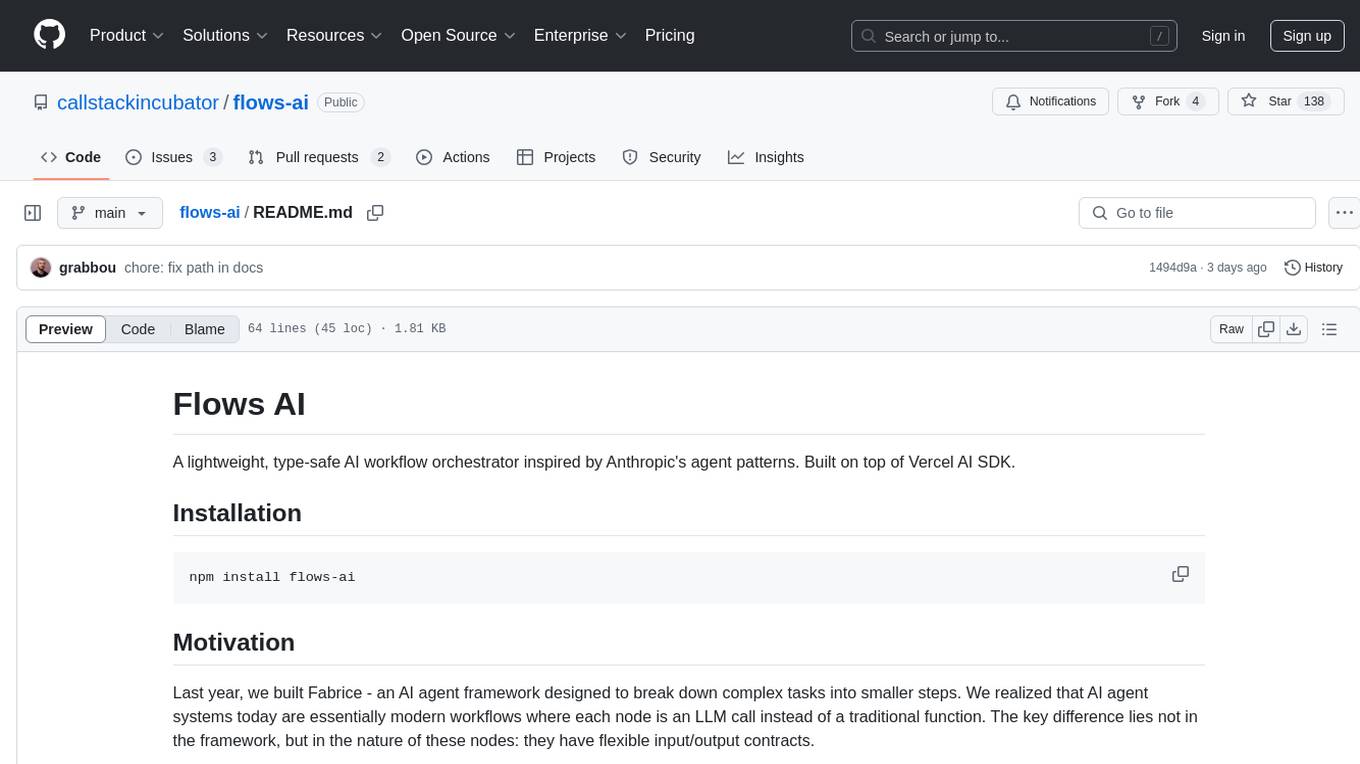
flows-ai
Flows AI is a lightweight, type-safe AI workflow orchestrator inspired by Anthropic's agent patterns and built on top of Vercel AI SDK. It provides a simple and deterministic way to build AI workflows by connecting different input/outputs together, either explicitly defining workflows or dynamically breaking down complex tasks using an orchestrator agent. The library is designed without classes or state, focusing on flexible input/output contracts for nodes.
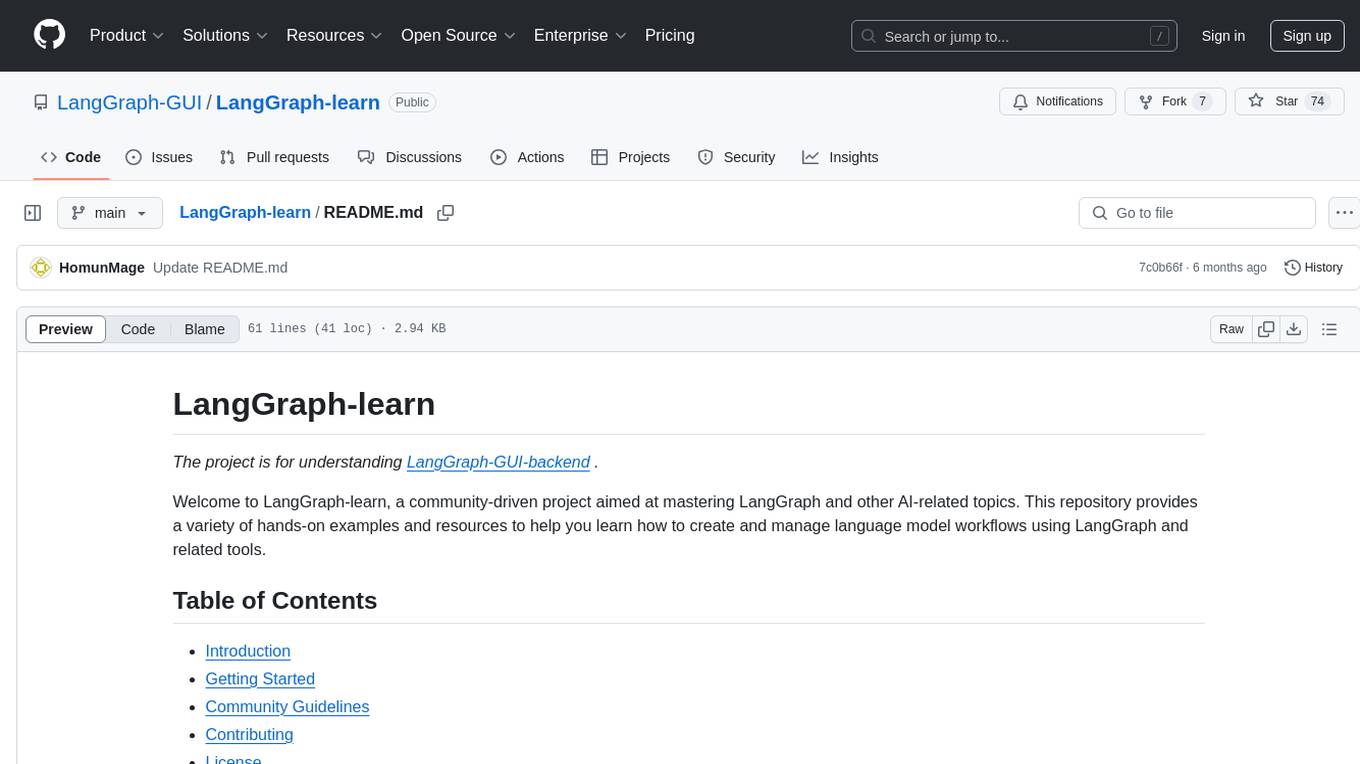
LangGraph-learn
LangGraph-learn is a community-driven project focused on mastering LangGraph and other AI-related topics. It provides hands-on examples and resources to help users learn how to create and manage language model workflows using LangGraph and related tools. The project aims to foster a collaborative learning environment for individuals interested in AI and machine learning by offering practical examples and tutorials on building efficient and reusable workflows involving language models.
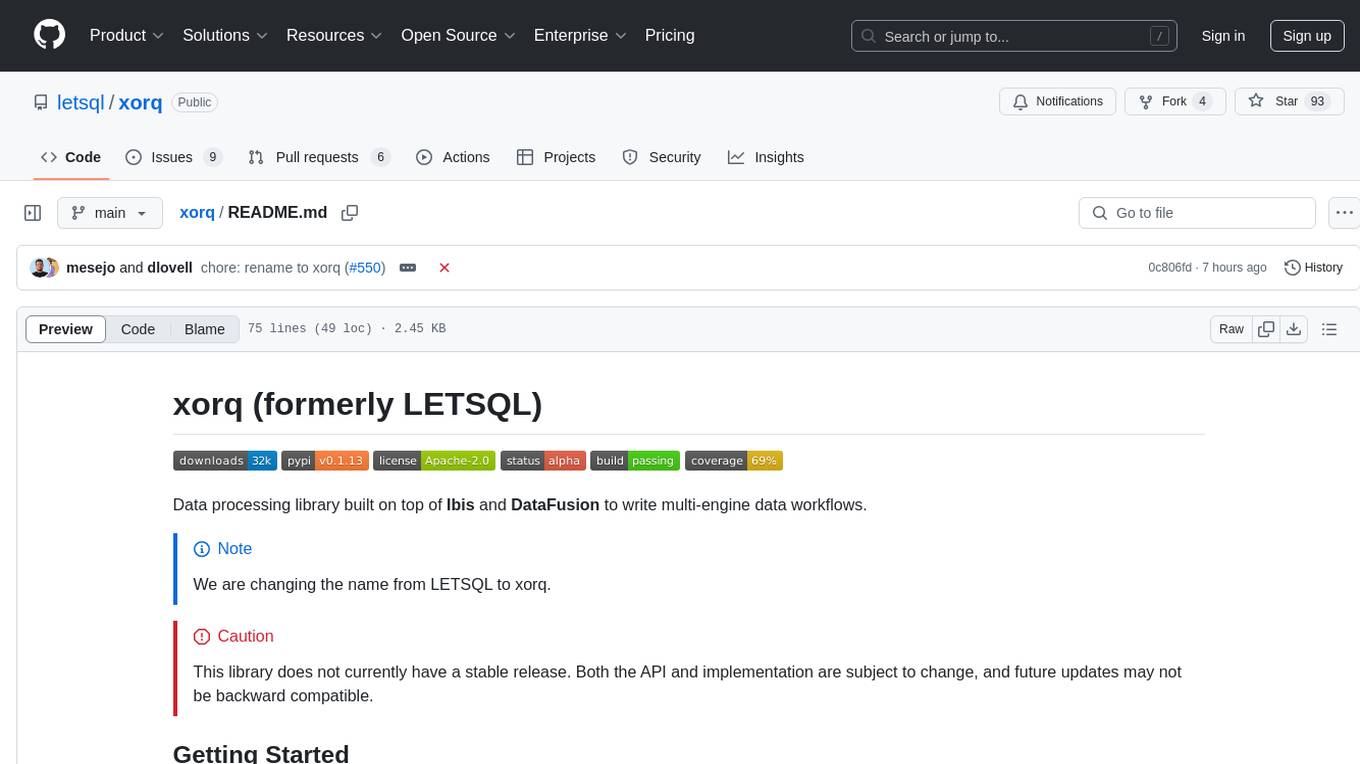
xorq
Xorq (formerly LETSQL) is a data processing library built on top of Ibis and DataFusion to write multi-engine data workflows. It provides a flexible and powerful tool for processing and analyzing data from various sources, enabling users to create complex data pipelines and perform advanced data transformations.
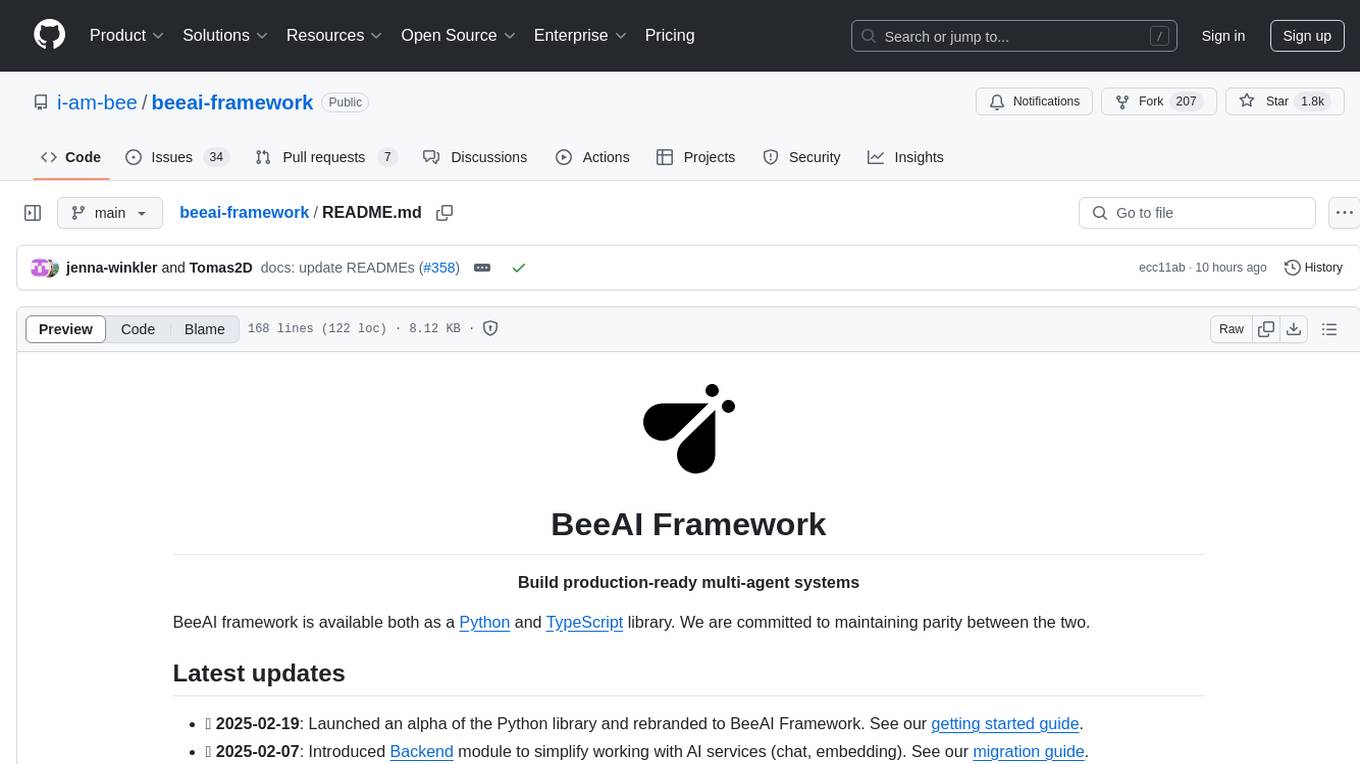
beeai-framework
BeeAI Framework is a versatile tool for building production-ready multi-agent systems. It offers flexibility in orchestrating agents, seamless integration with various models and tools, and production-grade controls for scaling. The framework supports Python and TypeScript libraries, enabling users to implement simple to complex multi-agent patterns, connect with AI services, and optimize token usage and resource management.
For similar jobs

sweep
Sweep is an AI junior developer that turns bugs and feature requests into code changes. It automatically handles developer experience improvements like adding type hints and improving test coverage.

teams-ai
The Teams AI Library is a software development kit (SDK) that helps developers create bots that can interact with Teams and Microsoft 365 applications. It is built on top of the Bot Framework SDK and simplifies the process of developing bots that interact with Teams' artificial intelligence capabilities. The SDK is available for JavaScript/TypeScript, .NET, and Python.

ai-guide
This guide is dedicated to Large Language Models (LLMs) that you can run on your home computer. It assumes your PC is a lower-end, non-gaming setup.

classifai
Supercharge WordPress Content Workflows and Engagement with Artificial Intelligence. Tap into leading cloud-based services like OpenAI, Microsoft Azure AI, Google Gemini and IBM Watson to augment your WordPress-powered websites. Publish content faster while improving SEO performance and increasing audience engagement. ClassifAI integrates Artificial Intelligence and Machine Learning technologies to lighten your workload and eliminate tedious tasks, giving you more time to create original content that matters.

chatbot-ui
Chatbot UI is an open-source AI chat app that allows users to create and deploy their own AI chatbots. It is easy to use and can be customized to fit any need. Chatbot UI is perfect for businesses, developers, and anyone who wants to create a chatbot.

BricksLLM
BricksLLM is a cloud native AI gateway written in Go. Currently, it provides native support for OpenAI, Anthropic, Azure OpenAI and vLLM. BricksLLM aims to provide enterprise level infrastructure that can power any LLM production use cases. Here are some use cases for BricksLLM: * Set LLM usage limits for users on different pricing tiers * Track LLM usage on a per user and per organization basis * Block or redact requests containing PIIs * Improve LLM reliability with failovers, retries and caching * Distribute API keys with rate limits and cost limits for internal development/production use cases * Distribute API keys with rate limits and cost limits for students

uAgents
uAgents is a Python library developed by Fetch.ai that allows for the creation of autonomous AI agents. These agents can perform various tasks on a schedule or take action on various events. uAgents are easy to create and manage, and they are connected to a fast-growing network of other uAgents. They are also secure, with cryptographically secured messages and wallets.

griptape
Griptape is a modular Python framework for building AI-powered applications that securely connect to your enterprise data and APIs. It offers developers the ability to maintain control and flexibility at every step. Griptape's core components include Structures (Agents, Pipelines, and Workflows), Tasks, Tools, Memory (Conversation Memory, Task Memory, and Meta Memory), Drivers (Prompt and Embedding Drivers, Vector Store Drivers, Image Generation Drivers, Image Query Drivers, SQL Drivers, Web Scraper Drivers, and Conversation Memory Drivers), Engines (Query Engines, Extraction Engines, Summary Engines, Image Generation Engines, and Image Query Engines), and additional components (Rulesets, Loaders, Artifacts, Chunkers, and Tokenizers). Griptape enables developers to create AI-powered applications with ease and efficiency.
